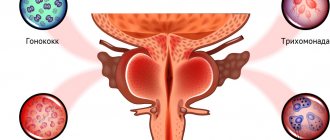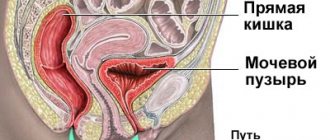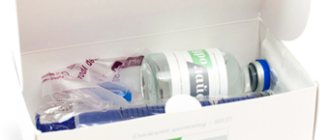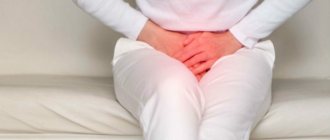Candidal cystitis: symptoms and causes of the disease
Frequent urge to urinate, reduction in portions of urine excreted, a feeling of incomplete emptying of the bladder - these are all manifestations of canida cystitis.
The clinical picture also includes changes in the urine - it becomes cloudy, acquires a pungent odor, and may contain blood. [16, 39] When cystitis worsens, patients experience sharp pain in the lower abdomen and fever. During the act of urination, itching and burning are felt in the perineum. [16, 39]
The causative agent of the inflammatory process in candidal cystitis is the fungus Candida Albicans. The infection can enter the bladder through an ascending or descending route. In the first case, a fungal infection enters the urethra from the external genitalia, after which it penetrates the bladder and causes inflammation. Sometimes infection occurs during catheterization, but the external genitalia are not affected. [38, 40]
The descending path is realized when the skin, stomach and other organs are affected by the fungus. After this, the pathogen penetrates the bloodstream, spreads throughout the body and penetrates the bladder. Typically, Candida fungus becomes especially active during a period of decline in immune function. [38, 40]
How to choose a treatment regimen for candidal cystitis?
The choice of treatment tactics is based on the results of complex diagnostics. The patient needs to consult with a urologist and therapist, and undergo an examination. Usually, after examination by specialists, a general urinalysis, serological (PCR, ELISA, RNGA), as well as microscopic examinations are carried out, which allow identifying the pathogen. [40]
A clearer clinical picture can be obtained by performing an ultrasound of the bladder. The study helps detect signs of the inflammatory process. For candidal cystitis in women, treatment is prescribed only by a doctor. The treatment regimen depends on the nature of the pathogen. [40]
The fact is that not all antifungal drugs can destroy it, and the use of antibiotics can only worsen the situation. With the simultaneous development of candidiasis and cystitis, patients must follow a drinking regimen, diet, and sexual abstinence. It is important to understand that both partners need treatment. [16, 40]
Nystatin
Nystatin is an “old” antifungal antibiotic, representing a group of polyenes (so-called natural antibiotics) on pharmacy counters. The drug has a very narrow specialization, showing its antimycotic activity against only yeast-like fungi of the genus Candida. This happens as follows: nystatin interacts with sterols that are part of the cell membranes of fungi. As a result, the permeability of cell membranes is disrupted, which entails the release of the main components of the fungal cell into the wild. The action of nystatin is characterized as fungistatic, i.e. inhibiting the growth and reproduction of fungi. After removing the fungistatic agent, their growth has every chance of resuming.
Nystatin is available in four dosage forms: tablets, ointment, rectal and vaginal suppositories. When taking the drug orally, it is poorly absorbed from the gastrointestinal tract. Local application of nystatin avoids its absorption into the systemic circulation. The drug does not accumulate in the body and is excreted in feces. Indications for use of the drug will vary depending on the form of release. Thus, vaginal and rectal suppositories are used according to the site of administration, i.e. in the first case it will be vaginal candidiasis, and in the second - candidiasis of the lower intestine. Tablets are used for candidiasis of the skin and mucous membranes, as well as internal organs, ointment - only for the skin and mucous membranes. For prophylactic purposes, nystatin can be used in all forms of release. It should be noted that at present this drug, in the language of Internet memes, is “no longer a cake” and is gradually losing its position in relation to a number of diseases.
Thus, for decades, nystatin was practically the only drug for the treatment of oral candidiasis. However, previously collected information about the 90% effectiveness of this drug in modern realities has not been confirmed, and in clinical practice, fluconazole has proven itself much more successful in treating this disease.
When internal organs are affected by candida, nystatin is prescribed orally, regardless of diet. Adults should take 500,000 units 4-8 times a day. For generalized candidiasis (when the fungal infection acquires impressive proportions), the daily dose of nystatin can reach up to 6,000,000 units. The doses of the drug used in pediatric practice depend on the age of the child: 250,000 units 3-4 times a day (from 1 to 3 years), 250,000-500,000 units 4 times a day (over 3 years). The duration of treatment is on average 10-14 days with the possibility of repeating the drug course after a week's "rest" from antimycotic therapy. The ointment should be applied to the areas of skin and mucous membranes affected by candida in a thin layer 2 times a day for 7-10 days. A combination of ointment and nystatin tablets is allowed. Before inserting vaginal suppositories into the vagina, the necessary hygienic procedures should be carried out. Dosage regimen: 1 suppository twice a day, morning and evening. The course of treatment is 10-14 days. The dosage frequency and dosage regimen for rectal suppositories is similar, only the route of administration into the body differs.
Thrush with cystitis: how to avoid?
To prevent infection of the bladder with Candida fungi, you must maintain a regimen of sexual abstinence until the end of therapy. Even when using a condom, the urethra can become infected, leading to the development of candidal cystitis. [16, 40]
This pathology, in turn, can cause infection of the external genitalia. To avoid this, you need to take special medications that maintain normal vaginal flora. [40]
Thrush and candidal cystitis often “act” in tandem. Therefore, patients must understand the importance of preventive measures and comply with them. [40] Herbal medicine in the treatment of cystitis in women
In the complex therapy of infectious and inflammatory diseases of the urinary tract, herbal remedies, for example, Fitolysin® paste, can be used. The herbal diuretic contains 4 essential oils (orange, pine, sage, mint), as well as 9 medicinal extracts (goldenrod, lovage, birch leaves, etc.). [1, 6, 26]
The drug for the treatment of cystitis Fitolysin® is available in the form of a paste for the preparation of an oral suspension. This form ensures faster absorption of the active components. They are delivered directly to the site of inflammation faster than in the case of taking tablets. [2]
Fitolysin® paste
More details
The herbal diuretic has diuretic, anti-inflammatory, antispasmodic effects. [6] The drug is produced in Europe. Its production meets international GMP standards [3]. It helps eliminate inflammation and pain, normalize urination, flush sand from the urinary tract and reduce the crystallization of urine minerals [1,6].
Thrush: a common problem with improper treatment
Every woman knows what candidiasis (“thrush”) is. And each has a “proven” remedy. But what if symptoms return? Why can candidiasis persist? And how to find an individually effective medicine?
Why does Candida fungus “grow”?
1. Lactobacillus deficiency
As is known, the basis of female microflora is lactobacilli. The share of which, ideally, is at least 85%.
The remaining 15% are dozens of species of opportunistic bacteria and 4 species of Candida fungi. The presence of which is acceptable and safe, but only in limited quantities.
Control of the number of such pathogens is carried out by lactobacilli, which secrete lactic acid and hydrogen peroxide. And while there are enough of the latter, “conditionally harmful” ones are not capable of reproduction.
To maintain normal activity, lactobacilli need food - glycogen from the surface cells of the vaginal epithelium ("dead from old age").
And the rate of epithelium renewal, that is, “replenishment of food reserves,” in turn, depends on the balance of estrogen.
Thus, a decrease in lactobacilli and the “overgrowth” of fungi and other pathogens against this background is often associated with an imbalance of estrogen and is observed with:
- Diseases or decreased ovarian function,
- When taking certain oral contraceptives;
- Against the backdrop of acute stress
- Against the background of sudden weight loss (fat is needed for the synthesis of estrogens).
Mechanically, frequent douching and other similar procedures that “wash away” the surface layer of cells and a certain amount of beneficial flora can provoke disturbances.
Well, among other reasons:
- inflammatory diseases
- sexually transmitted infections
- long-term and/or “non-targeted” use of antibiotics
- and the use of antibacterial/antiseptic suppositories.
2. Insufficiency of immunity
“Thrush” may also be associated with immune disorders, since Candida is “under the supervision” of local defenses.
And another risk factor for candidiasis are:
- various immunodeficiency conditions
- chronic pathologies that adversely affect the immune system (diabetes mellitus, thyroid pathologies, oncological processes, etc.),
- taking glucorticoid hormones.
3. Household reasons
Well, the most “banal” provocateur of the violation may be the regular use of sanitary pads, wearing synthetic underwear and some other factors that create conditions for increased local temperature, oxygen deficiency and high humidity. That is, what fungi of the genus Candida “love”.
Candidiasis or “other”
If you suspect a risk of candidiasis, you can already based on the presence of the listed factors. It is not easy to distinguish candidiasis from vaginosis at first glance.
At the same time, the treatment of one and another pathology is fundamentally different. And the use of non-targeted therapy leads to chronicity of the process and the development of complications, including infertility.
The nature of the discharge can help determine candidiasis by eye - white, cheesy, with a sour odor, accompanied by severe itching. However, not everyone has such “classic” signs and not always.
Vaginosis (bacterial vaginosis) often “has” copious white-gray, sometimes foamy, discharge, with an alkaline (“fishy”) odor, which intensifies after sexual intercourse. Sometimes with itching. However, even here the nature of the symptoms varies greatly. And, among other things, violations can be combined.
Thus, to accurately distinguish candidiasis from other forms of vaginal dysbiosis, a flora analysis will be required.
And the most complete picture can be obtained from the “Florocenosis” analysis.
The study includes calculations:
- lactobacilli,
- causative agents of bacterial vaginosis Gardnerella vaginalis
- and Atopobium vaginae,
- Enterobacteriaceae
- Ureaplasma urealyticum,
- Candida albicans
which makes it possible to differentiate several types of dysbiosis at once and apply the correct treatment.
Typing fungi of the genus Candida allows you to select an effective antifungal drug. After all, not everyone knows, but some of the listed types have pronounced resistance to popular means. You can get the typing result in the “Florocenosis” test or submit a vaginal smear for a separate fungal typing test in order to accurately determine the type of thrush pathogen and select the right antifungal drug.
Prevention of candidiasis
Summarizing all of the above and adhering to national clinical recommendations, we can conclude that the prevention of “thrush” in both women and men comes down to:
- maintaining personal hygiene,
- the use of barrier methods of contraception,
- abstaining from unprotected sexual intercourse with frequent changes of partners,
- avoiding uncontrolled use of hormonal and antibacterial drugs,
- exclusion from the “wardrobe” of tight, synthetic underwear,
- monitoring the state of general, hormonal and reproductive health.
In addition, women should:
- limit the use of sanitary pads to menstruation days only,
- exclude douching, vaginal douche and other similar procedures,
- prevent long-term use of intrauterine devices and vaginal diaphragms.
And pregnant women require special attention, due to physiological weakening of the immune system, changes in hormonal levels and stagnation of lymph in the pelvis due to increased intra-abdominal pressure. Which creates “favorable” conditions for the development of vaginal dysbiosis.







